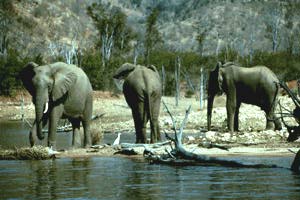
The Matusadona National Park is one of several protected wildlife areas with shorelines on Lake Kariba. Some 338 000 acres in area, it is bounded on the west by the Ume River and on the east by the Sanyati River. Two-thirds of it lies south of the Zambezi Escarpment, here formed by the 1 968 foot -high Matuzviadonha Hills from which it takes its name.
Open woodlands on the plateau behind the escarpment are dominated by Julbernardia globiflora and have suffered considerable damage from an overpopulation of elephant. The mountain acacia, Brachystegia glaucescens, is also common on the slopes and ridges of the escarpment.
From the plateau the park falls abruptly to a flat, low-lying area covered mainly with mopane scrub and woodland and with dense patches of jesse bush. The entire northern boundary of the park is created by the lakeshore itself. This shoreline, which is subjected to irregular variations in water level caused by fluctuations in annual rainfall, is still in a state of rapid ecological change and development.
Along much of it are 'drowned forests', up to .62 miles wide, containing dead trees standing more than 25 years after the filling of the lake. Many of the animals rescued during 'Operation Noah' when the lake was filling were released into the Matusadona, which now holds fair to good populations of most mammals occurring in the Zambezi region.
Some sensitive species may have declined because of the loss of the former natural riverine habitats; bushbuck and waterbuck, for example, are relatively scarce. The low numbers of roan and eland, which are generally confined to the plateau behind the escarpment, are also a matter for concern. However, impala, kudu, zebra and warthog are all common on the valley floor and sable occur in numerous small groups on the plateau.
An elephant population of about 600 is culled from time to time to relieve pressures on the woodlands. Buffalo are especially prominent; herds up to 1 000 strong often congregate along the shoreline in the dry season. Their population is thought to be growing at about 9% per annum, and this rapid expansion is caused largely by the development of the wide swards of torpedo grass, Panicum repens, along the shoreline.
This swamp grass is indigenous to the Zambezi valley. It was generally absent from the lakeshore until 1970, when a combination of circumstances including the decline of the Kariba weed, Salvinia molesta, enabled it to gain a foothold on what were, until then, rather barren shores.
The dying Salvinia created an ideal mulch for the torpedo grass. It can survive for long periods under water and becomes available to buffalo and other herbivores towards the end of the dry season when other sources of fodder are largely depleted.
Lion, leopard, hyaena and other predators occur in good numbers throughout the park. There have also been isolated reports of cheetah.
There is a small but important population of the endangered black rhinoceros, found mainly along the foot of the escarpment. Eight white rhinoceros were introduced into the park in 1984 but did not survive, probably because they had lost their natural immunity to sleeping sickness over many years of captive breeding in tsetse-free areas.
Hippopotamus and crocodile declined after the lake filled but are now recovering well. Hippopotamus have benefited from the development of the torpedo grass swards and the deeply incised shoreline provides hundreds of suitably sheltered habitats. A recent survey of the crocodile population estimated their density at one adult animal for evey 656 feet of shoreline.
One of the Matusadona's most compelling features is its luxuriant birdlife; over 240 species have been recorded in the park. The fish eagle is common along the lakeshore where it makes use of the dead trees as nesting sites. Most parts of the lakeshore have conspicuous populations of grey herons, goliath herons, great white herons and saddlebill storks.
Plovers, waders and geese are generally abundant and there are notable populations of osprey, woolly-necked storks, open-billed storks, white-winged plovers and red-winged pratincoles. There are several large colonies of darters and reed cormorants within the treelines, and at least one colony of white-breasted cormorants has appeared recently.
Flamingoes have been recorded from time to time. Bee-eater colonies are often found in the sandstone banks and cliffs of the minor rivers that traverse the valley floor. Most local raptors are present in good numbers.
The Matusadona National Park is most easily accessible by boat from the town of Kariba, some 12.4 miles north. Several commercial tourist camps are located around the borders of the park. It is also possible to enter the Matusadona from the gravel Karoi-Kamativi road south of the escarpment.
A four-wheel drive vehicle is neccesary to negotiate the access road, which leads to the park headquarters at Tashinga. The Department of National Parks maintains lodges and campsites near Tashinga and a basic campsite at Sanyati West, close to the entrance to the Sanyati Gorge. Matusadona was proclaimed a non-hunting reserve in 1958 and became a game reserve in 1963. It was given full National Park status under the Parks and Wild Life Act (1975).